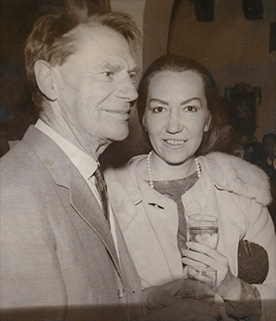
Semblance
I met Ernst in 1961 at the opening of a theater in Munich. His face in the crowd affected me so much that I trembled. Later, I recognized him in awe when we were introduced. That same night began a series of encounters marked by the wonderful discovery of a mutual affinity. After two years we married and a few months later, we started our journey to Mexico (“that magnificent and moving land”), my place of origin, where, fascinated, remained until his death in 1984.
By his side I learned that for him, painting was a commitment to life, a confession of responsibility towards it; that being a painter was just a more concrete dimension of being men; I learned that, by devoting his life to art, painting was never more essential than living.
I also understood that for Ernst, that realization always demanded facing the great Uncertainty. It fed his art and also his joy of love. It marked, as well, the great humility of his actions: “I became a responsible witness, trying to guess where I come from and where I go”.
Gertrudis Zenzes
“Me convertí en
testigo responsable,
tratando de adivinar
de dónde vengo y
adónde voy”.
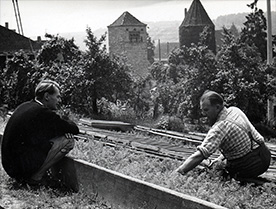
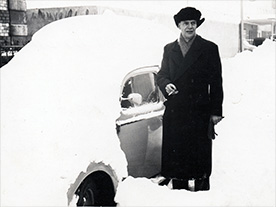
Ernst Saemisch was born in Central Germany, in Moers, in 1902. His childhood passed near Freiburg, a city in the south, where Germany, France, and Switzerland converge; this influenced his family´s open-mindedness. He lived with his parents in Günterstal, in a villa whose gardens merged into the Black Forest. There, he developed the close bond with nature that accompanied him all his life, his artistic work and shaped his ideas on art.
The paternal home also provided him with a natural anchorage in European tradition. They were descendants of Ranke and Brentano; his parents led a daily life enlivened by intense debates with renowned philosophers, artists, and scientists who used to visit the house. His father, Moritz Saemisch, son of Theodor Saemisch, founder of modern ophthalmology, was Finance Minister during the Weimar Republic. His mother, who painted with effortless innocence, introduced him to the passion for artistic creation.
The family idyll broke when the First World War erupted. His father took him to distribute medicines in the improvised field hospitals. Ernst was always grateful for this early and cruel experience; he had the certainty that creative ability must be tempered in the confrontation with reality.
On Christmas 1917, his mother died. He enrolled as a boarding student in an international school in Suoz, Switzerland, a neutral country during the war. In that broad-minded and free environment, he soothed the pain of orphanhood with the warm encounter of Einstein, with whom he used to go on long ski rides. This awakened memories of his friendship with Haber and Nernst, Nobel laureates in Physics. This closeness with science left a mark on Saemisch’s artistic work.
The visit to a great exhibition of new French painting in Switzerland made a strong impression on him. He discovered “the pleasure of life and the rampant joy of the impressionists, and the sobriety of the cubists”. He came to sense the radiant magic of blue, red and yellow… that strength captured in the mystery of the unspeakable.
When he returned to Germany in 1919, he found a country marked by four years of war and defeat. The social and spiritual structure had been shaken to its foundations, and the reality was one of misery and death. The economic crisis led Saemisch to start working as a writer, publishing articles and essays about culture and politics. At the same time, he painted and created engravings. From this time, his first wood engraving survives, standing in contrast to the prevailing chaos and decadence.
Saemisch found a similar way of expression in expressionism, a dark and striking opponent of the culture of good taste. Expressionism implied not only an aesthetical renovation but also one in all human life; it supported a way of creation that originated deep inside man: artists saw themselves as servants of a sacred matter. This idea of art, and the vital attitude that it embraced, was assumed by Saemisch then and forever. All his work would bear the mark of this movement: his passion for contrasts, his rejection of the indistinct, the prioritization of the soul and the feelings over cold rationality, his metaphysical inspiration, and his libertarian drive.
Saemisch decided to be a painter and he enrolled at the Kassel State Art Academy. However, he soon became disappointed by the strict academicism. When he publishes his critique in the press, he is expelled from the Academy under threat of police intervention. At this school, however, the friendship with a young Chinese painter, whose easel stood beside his, had important consequences for his artistic work. Saemisch recalled: “By his side, I began to feel the wholeness on which the great Chinese culture is based; I came to know his art, especially the ink painting, so spiritual, sometimes marked by delicate lyricism; I learned to distinguish the marvelous sensitivity of the line, which submits to the force of emptiness”. Since then, in the different stages of his artistic work, he would explore this oriental bond, summed up in his preference for paintbrushes, ink and Japanese paper.
After he left the Academy, the best path for him was the recently founded Bauhaus in Weimar. Here, Ernst found the right spiritual and human atmosphere to strengthen the search in which he was committed, and began the conquest of that broad space between figurative painting and abstract painting. Spending time with Feininger, but specially with Paul Klee, influenced by Kandinsky’s fearlessness, strengthening his ideals by Gropius, guided by the flawless didactics of Itten and protected by the medieval community spirit that prevailed at Bauhaus, he is able to achieve the inner freedom that would lead him to find his own style.
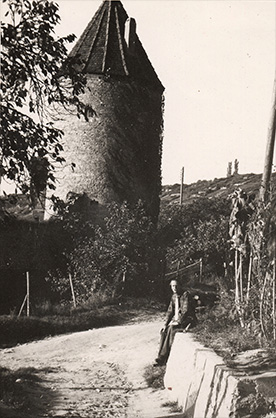
“Siento el impulso
de alcanzar el orden
íntimo de las cosas;
un orden anterior
a toda estética; un
orden relacionado
con la genealogía
del hombre”
In a sudden visit to Hamburg, he was captivated by the vastness of the sea and he enlisted as a sailor in one of the last sailing merchant ships; he traveled from Scandinavia to the South of Africa accompanied by his inseparable palette and the works of Shakespeare. “It was a marvelous and unique time, when I started to grow as a painter”. He became part of the group of sailors, his sketches passing from hand to hand throughout the dining room. In this community, he discovered the same spirit of solidarity that supported him at Bauhaus.
Back in Berlin a few years later, he began to successfully exhibit his works and he immersed himself in the flourishing cultural life of the time. At the museums he discovered the Italian artists from the early Renaissance: Cimabue, Duccio, Giotto, and he sensed the great transformation that they supported: “To ensure and care for the unity of the world, that is the true mission of the artists”.
Encouraged by the prevailing restlessness, he frequently traveled, working as a journalist in Europe, the Soviet Union and North Africa. His vivacious stories where full of thousands of anecdotes: Lenin in Vienna, so impressive to see him up close; the tenderness of Gorki, so captivating; the subtle poetry of the Portuguese fishermen who taught him to dance the tarantella; and the marvelous perception of other time dimension, while observing scarabs in the sand of the desert, integrated into a group of Bedouins, for whom he felt the deepest respect…
His world view and his artistic style were formed throughout his life. Ernst Saemisch distanced himself from the irrationalism and nationalism that the Nazis used to consolidate their power. In contrast to the avoidance of serious social problems, Saemisch faced reality with lucidity and passion, as he expressed by saying: “Horror and embarrassment make me hesitate to draw the curtain that darkened those terrible times from 1933 to 1945”. Because of the economic crisis that complicated the exhibition and publication of his work, he chose a stable job at the press agency of Germany, first in the Wolfs Telegraphen Büro and then in the Deutsche Presse Agentur, where he eventually became director of the Foreign Section.
From that position Saemisch witnessed with sorrow the decline of the intellectual and artistic life in Germany, while his vital space was narrowed more and more. The veiled threats prevented him from painting and his situation became unsustainable. Thanks to some friends abroad, he managed to relocate to the front in Finland, under the leadership of Marshal Mannerheim.
1945 marked a radical change in Ernst Saemisch’s life, he described it as a marvelous turn towards freedom, both in art and in his personal life. At that time, Germany began to see the last works of artists like Braque, Matisse and Picasso. The authorities of the French occupation invited a group of German painters, including Saemisch, on a couple of field trips around France; he was the guide of the last of these trips. Despite the economic conditions that led him to grow tobacco in the family house at Günterstal to survive, Saemisch continued painting tirelessly, exploring infinite variations on recurring subjects and consolidating his style
In this period, Saemisch exhibited in cities like Freiburg, Zurich and Munich. In 1955, he moved to Sommerhausen, a village near the Main River, where he found a structured daily life that inspired paintings of great beauty. He sought greater transparency, and aimed to reveal the harmony or the antagonism of the forces of existence through his works. Beyond his figurative concerns, he dedicated himself to explore the interior structure of his paintings. In this process of “realization”, he found in Cézanne an inspiring partner with the leitmotiv “Faire la musique devant la nature”, derived from Cézanne’s motto “faire l’ordre devant la nature”. In winter, he lived in a medieval tower, where the roof’s geometry outside his window inspired an artistic expression of great abstraction and strength.
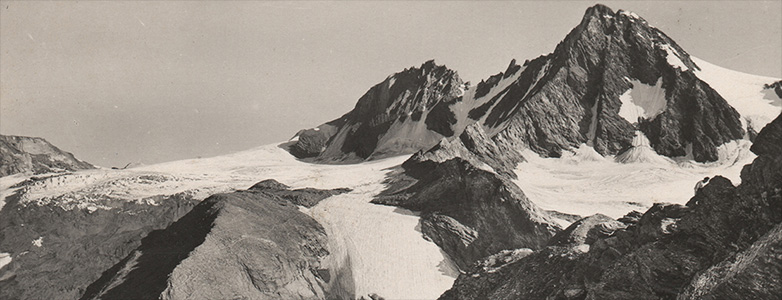
Sometimes he interrupted his stay in Sommerhausen with long excursions to the rocky ridges of the Austrian Alps, where he recreated a fine abstraction based on structures he discovered in the rocks. “I feel the drive to reach the inner order of things; an order preceding all aesthetics; an order related to the genealogy of humankind.”
Attracted by the rich cultural life of Munich and the presence of important old friends, he relocated there. He exhibited at the Günter Francke gallery and connected with the Friends of Modern Art Society, directed by Franz Roh. After the impact of his essay about the book “The immortality of the muses”, he was invited to write for various magazines, newspapers and to participate in radio broadcasts. At the same time, he became director of the recently opened “Uraufführungsbühne” theater, and wrote about art.
One of the decisive moments in his life occurred in a visit to a museum in Munich, where a pre-Columbian art exhibit fascinated him because of the intense spirituality through which it transfigured human existence and connected it cosmically.
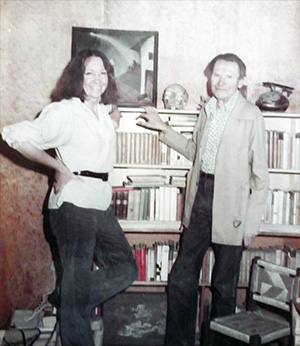
In 1963, after suffering a serious heart attack, he married the Mexican Gertrudis Zenzes, and moved to the “moving land” of Mexico. Here, absorbed by the encounter with its mysteries, he led a life of retreat dedicated to meditation and painting. He settled in Valle de Bravo, State of Mexico, where he built his house. In the very personal architecture of this house, Saemisch experimented with bold solutions that created a warm and harmonious environment. Unintentionally, he also played with time: the Black Forest of his childhood reappeared in the audacious cadence of the geometric traces that united roofs and windows. Additionally, the Sommerhausen tower and the ship bridge were represented with round windows.
In this house, his son Canek grew up and became the focal point of profound love, deep affection and respect for Ernst, who chose not to interfere in his natural development. Canek embodies the confluence of two cultural heritage Germany and Mexico.
The thousands of books that Ernst brought with him, some rescued from the ravages of war, found refuge in this house. He was a fervent reader and his rich library revealed the freedom of his spirit: Homer, Virgil, Dante, Shakespeare, Cervantes, Goethe and Tolstoy were always within reach. With the same enthusiasm as a teenager making new friends, he immersed himself in contemporary authors. In the final years of his life, science became an essential reading: “its marvelous course hasn’t destroyed knowledge spaces, but with deep intelligence it has merged them; this moves me and gives me confidence to create”.
Poetry and music were daily sources of inspiration. His record collection encompassed all periods and styles; yet, he dedicated most of his time to composers like Palestrina, Du Fay, Monteverdi, Bach, Mozart and Schubert.
Living alternately in Valle de Bravo, Mexico City and the Contreras hills, he worked tirelessly; each finished painting was preceded by hundreds of sketches, throughout which he absorbed the subject until it became his own. In his workshop, sometimes wearing a white garment of Otomi origin, he irradiated a halo of purity, transfiguring himself in the abstract process of painting.
In the solitude of Tierra Caliente, surrendered to the power of the sun and the silence of the undulating mountains, he limited himself to a box of inks and watercolors, creating with “ardent strength subdued to shapes”.
At times, a sharp thud would break his concentration. There was no shock by now it was something familiar: the snake passing by. For years, the image of the straight snake hunted him. In numerous sketches he prefigured the series of paintings (pastels, charcoals, inks and oils from 1966 to 1970), producing variations on the theme of “The Man and the Snake”, where the man sleeps and the snake watches. These works reach in metaphysical implications, were deeply nourished by his devotion to the idea of the pre-Hispanic world.
In the series “The Marvelous Catch”, there is a beautiful transition from figurative representation of the act of fishing, with obvious references like fishermen tightening nets, to the abstraction of the “marvelous catch”, where various small geometric shapes form a celestial allusion.
The series “Bars” (1980-1981), painted in pastel, originates from the gothic stained glass windows that had impressed him since his youth: “The colors, my vital element, trapped in the crystals of rigid structure, have a life so immensely rich that they’re able to support and even exceed the merciless structures of the spirit… In these paintings, the black lines, bearers of the rhythm of the pictorial occurrence, exalt the colors’ intensity as they emerge behind or between the bars. The colors aren’t prisoners behind them…The bars function as a means to render the world’s spiritual life, like passing through the other, the different, the alien”.
From 1982, Ernst settles in Mexico City once again. Despite his advancing illness, his spiritual intensity and joviality remained unbroken. His friend, the painter Alfredo León suggested a retrospective exhibition in the Tepito neighborhood, where he taught painting. This exhibition for him meant “breaking out of the narrow elitist art circle and perhaps the beginning of another phase of my long life”. An unexpected journey of the teacher Alfredo León, motivated Ernst to take charge of teaching the group of young painters. He embraced as his primary mission the awakening of confidence in the freedom to create. Ernst dedicated his last months of life to traveling to Tepito with great affection and excitement: “Working as an old man among these young people is a great gift of life, for which I am very grateful…”.
At times, however, his gaze was dominated by melancholy, and his face bore an expression laden with the pain of knowing. Goethe has become an indispensable reading companion for him. It seemed that he connected with the German poet in the ethics of silence, as both penetrated the ineffable zone of knowledge. A note, significantly crossed out, reads: “But there is another sadness: for the pain of the world, the darkness and death. Only the sublime poets can or must talk about it.”
Ernst continued working on his last paintings, seeking the path to the deepest of freedoms. He uses oil and acrylic. However, his work was interrupted by a serious health crisis that led him to hospital.
When he returned, he picked up the paintbrush once again. He had transcended previous boundaries. He began the series “Cosmos” and achieved unfinished paintings of serene beauty that pointed to a harmony where movement, paradoxically, ceased. However, at the beginning of this new cosmic journey, death interrupted him.
Gertrudis y Carla Zenzes